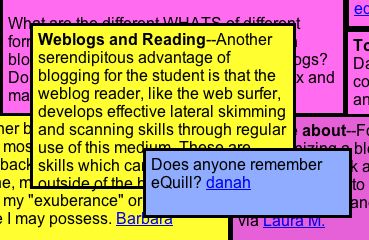[From OM]
I’ve never enjoyed coming up with pithy terms, labels or titles. While i loathe this form of production, i recognize that articles need a title and a phenomenon needs a label. We need common language to talk particular issues or sites. For this reason, i have acquiesced to the term “social tools” even though my deconstructionist tendencies cringe at the limitations of this particular term.
Instead of deconstructing the term, which will inevitably lead to dismissal, i think that it would be proper to begin this project by scoping what i believe we are addressing. I would like to begin by scoping “social tools” in the context of this blog’s intentions. Perhaps doing so will provide a framework for future discussions or at least articulate the boundaries that i will use in constructing my posts.
Let me begin by acknowledging that this term has striking parallels in intention and consideration to “social software.” For this reason, i think that it might be prudent to consider Christopher Allen’s attempt to trace the evolution of the term, my concerns with the term, and Clay’s disagreement with me. This should provide the right amount of angst and echo-chamber behavior to begin. Now let’s add the positivist spin.
When one is social, one is inevitably interacting with other people, whether they are intimate friends or strangers. Sociability may include (non)verbal communication, shared behaviors, movements towards community creation or productions that lead to the creation and maintenance of a society. To be social is not simply to communicate, but to engage in practices dedicated that will affect the relationship between people.
Social tools (or software, technologies) are fundamentally the tools dedicated to helping people be social. Tools for instant messaging, blogging, emailing, social networking, photo-sharing are all tools to help people be social. One could argue that tools that help people create content generally may help them in sociability. For example, if emacs helps me build software that … I respectfully disagree with this approach. In scoping social tools, i am only interested in the tools that not only allow for and encourage sociability, but are designed for such. Furthermore, social tools are seen by their participants as first about sociability and second about content production. Of course, there are always exceptions – there are certainly bloggers who have no intention of being sociable. For this reason, i see social tools as a radial category and i am only interested in the prototypical tools and behaviors. When appropriate, i will address the non-prototypical cases, but that is not going to be my emphasis.
There are a series of features that many prototypical social tools have: – textual, audio or visual communication capabilities – opportunity for identity formation and projection (not limited to profiles) – social networking (exposed or unexposed, articulated or behavioral) – “speaker”/audience relationships (and thus, power dynamics)
In most social tools, the content might be the most visible production, but for most participants, it is these features that motivate participation, as these allow for sociable interaction. These are also the features that signify the context in which content production is occurring. For this reason, my posts will be centered on these features first, the social tools’ participants second and the actual technologies third.
